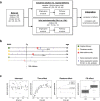Common patterns of gene regulation associated with Cesarean section and the development of islet autoimmunity - indications of immune cell activation
- PMID: 31000755
- PMCID: PMC6472354
- DOI: 10.1038/s41598-019-42750-5
Common patterns of gene regulation associated with Cesarean section and the development of islet autoimmunity - indications of immune cell activation
Abstract
Birth by Cesarean section increases the risk of developing type 1 diabetes later in life. We aimed to elucidate common regulatory processes observed after Cesarean section and the development of islet autoimmunity, which precedes type 1 diabetes, by investigating the transcriptome of blood cells in the developing immune system. To investigate Cesarean section effects, we analyzed longitudinal gene expression profiles from peripheral blood mononuclear cells taken at several time points from children with increased familial and genetic risk for type 1 diabetes. For islet autoimmunity, we compared gene expression differences between children after initiation of islet autoimmunity and age-matched children who did not develop islet autoantibodies. Finally, we compared both results to identify common regulatory patterns. We identified the pentose phosphate pathway and pyrimidine metabolism - both involved in nucleotide synthesis and cell proliferation - to be differentially expressed in children born by Cesarean section and after islet autoimmunity. Comparison of global gene expression signatures showed that transcriptomic changes were systematically and significantly correlated between Cesarean section and islet autoimmunity. Moreover, signatures of both Cesarean section and islet autoimmunity correlated with transcriptional changes observed during activation of isolated CD4+ T lymphocytes. In conclusion, we identified shared molecular changes relating to immune cell activation in children born by Cesarean section and children who developed autoimmunity. Our results serve as a starting point for further investigations on how a type 1 diabetes risk factor impacts the young immune system at a molecular level.
Trial registration: ClinicalTrials.gov NCT01115621.
Conflict of interest statement
The authors declare no competing interests.
Figures





References
Publication types
MeSH terms
Substances
Associated data
LinkOut - more resources
Full Text Sources
Medical
Research Materials

